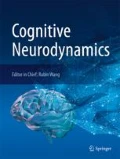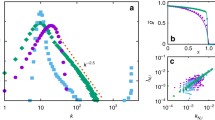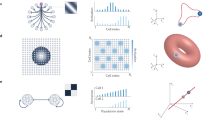Abstract
Many cognitive tasks involve transitions between distinct mental processes, which may range from discrete states to complex strategies. The ability of cortical networks to combine discrete jumps with continuous glides along ever changing trajectories, dubbed latching dynamics, may be essential for the emergence of the unique cognitive capacities of modern humans. Novel trajectories have to be followed in the multidimensional space of cortical activity for novel behaviours to be produced; yet, not everything changes: several lines of evidence point at recurring patterns in the sequence of activation of cortical areas in a variety of behaviours. To extend a mathematical model of latching dynamics beyond the simple unstructured auto-associative Potts network previously analysed, we introduce delayed structured connectivity and hetero-associative connection weights, and we explore their effects on the dynamics. A modular model in the small-world regime is considered, with modules arranged on a ring. The synaptic weights include a standard auto-associative component, stabilizing distinct patterns of activity, and a hetero-associative component, favoring transitions from one pattern, expressed in one module, to the next, in the next module. We then study, through simulations, how structural parameters, like those regulating rewiring probability, noise and feedback connections, determine sequential association dynamics.






Similar content being viewed by others
References
Abeles M (1982) Local cortical circuits: an electrophysiological study. Springer, Berlin
Amati D, Shallice T (2007) On the emergence of modern humans. Cognition 103:358–385
Amit DJ (1989) Modeling brain function: the world of attractor neural networks. Cambridge University Press, New York
Bassett DS, Bullmore E (2006) Small-world brain networks. Neuroscientist 6:512–523
Braitenberg V (1978) Cortical architectonics: general and areal. In: Bazier PH MAB (ed) Architectonics of the cerebral cortex. Raven press, New York, pp 443–465
Fulvi-Mari CC, Treves A (1998) Modeling neocortical areas with a modular neural network. Biosystems 48:47–55
Gerth S, beim Graben P (2009) Unifying syntactic theory and sentence processing difficulty through a connectionist minimalist parser. Cognitive Neurodynamics 3(4):297–316
Guo D, Li C (2010) Self-sustained irregular activity in 2-d small-world networks of excitatory and inhibitory neurons. IEEE Trans Neural Netw 21:895–905
Hauser M, Chomsky N, Fitch WT (2002) The language faculty: what is it, who has it, and how did it evolve? Science 298:1569–1579
James W (1892) The stream of consciousness. Psychology
Kanter I (1988) Potts-glass models of neural networks. Phys Rev A 37:2739–2742
Koechlin E, Summerfield C (2007) An information theoretical approach to prefrontal executive function. Trends Cogn Sci 11:229–235
Kropff E, Treves A (2005) The storage capacity of potts models for semantic memory retrieval. J Stat Mech Theory Exp 8:P08010
Kropff E, Treves A (2007) The complexity of latching transitions in large scale cortical networks. Nat Comput 2:169–185
Lansner A, Fransén E, Sandberg A (2003) Cell assembly dynamics in detailed and abstract attractor models of cortical associative memory. Theory Biosci 122(1):19–36
Li Y, Tsuda I (2013) Novelty-induced memory transmission between two nonequilibrium neural networks. Cogn Neurodyn 7(3):225–236
Mountcastle VB (1998) Perceptual neuroscience: the cerebral cortex. Harvard University Press, Cambridge, MA
Pulvermüller F, Knoblauch A (2009) Discrete combinatorial circuits emerging in neural networks: a mechanism for rules of grammar in the human brain? Neural Netw 22:161–172
Roxin A, Riecke H, Solla SA (2004) Self-sustained activity in a small world network of excitable neurons. Phys Rev Lett 92(19)198101:1–4
Russo E, Namboodiri VM, Treves A, Kropff E (2008) Free association transitions in models of cortical latching dynamics. New J Phy 10(015008):1–19
Russo E, Pirmoradian S, Treves A (2010) Associative latching dynamics vs syntax. Adv Cognit Neurodyn(II) 111–115
Russo, E, Treves, A (2012) Cortical free association dynamics: distinct phases of a latching network. Phys Rev E 85(5)051920:1–18
Seyed-Allaei S, Amati D, Shallice T(2010) Internally driven strategy change. Think Reason 16(4):308–331
Treves A (2005) Frontal latching networks: a possible neural basis for infinite recursion. Cogn Neuropsychol 22(3-4):276–291
Tsodyks M, Feigelman M (1998) The enhanced storage capacity in neural networks with low activity level. Europhys Lett 6(2):101–105
Watts D, Strogatz S (1998) Collective dynamics of ’small-world’ networks. Science 286:509–512
Wennekers T, Gunther P (2009) Syntactic sequencing in Hebbian cell assemblies. Cogn Neurodyn 3:429–441
Acknowledgments
S.S. thanks Eleonora Russo and Emilio Kropff for earnest and warmhearted assistance in sharing the idea of latching dynamics. S.S. and H.Y. are grateful for the support of the National Natural Science Foundation of China (61071180).
Author information
Authors and Affiliations
Corresponding author
Rights and permissions
About this article
Cite this article
Song, S., Yao, H. & Treves, A. A modular latching chain. Cogn Neurodyn 8, 37–46 (2014). https://doi.org/10.1007/s11571-013-9261-1
Received:
Revised:
Accepted:
Published:
Issue Date:
DOI: https://doi.org/10.1007/s11571-013-9261-1




